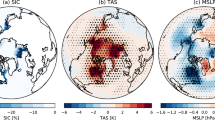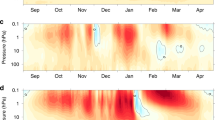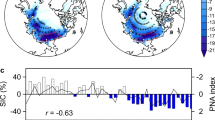Abstract
The wintertime Arctic stratospheric polar vortex has weakened over the past three decades, and consequently cold surface air from high latitudes is now more likely to move into the middle latitudes1,2,3,4,5. However, it is not known if the location of the polar vortex has also experienced a persistent change in response to Arctic climate change and whether any changes in the vortex position have implications for the climate system. Here, through the analysis of various data sets and model simulations, we show that the Arctic polar vortex shifted persistently towards the Eurasian continent and away from North America in February over the past three decades. This shift is found to be closely related to the enhanced zonal wavenumber-1 waves in response to Arctic sea-ice loss, particularly over the Barents–Kara seas (BKS). Increased snow cover over the Eurasian continent may also have contributed to the shift. Our analysis reveals that the vortex shift induces cooling over some parts of the Eurasian continent and North America which partly offsets the tropospheric climate warming there in the past three decades. The potential vortex shift in response to persistent sea-ice loss in the future6,7, and its associated climatic impact, deserve attention to better constrain future climate changes.
This is a preview of subscription content, access via your institution
Access options
Subscribe to this journal
Receive 12 print issues and online access
$209.00 per year
only $17.42 per issue
Buy this article
- Purchase on Springer Link
- Instant access to full article PDF
Prices may be subject to local taxes which are calculated during checkout




Similar content being viewed by others
References
Kim, B. M. et al. Weakening of the stratospheric polar vortex by Arctic sea-ice loss. Nat. Commun. 5, 4646 (2014).
Alexeev, V. A., Esau, I. N., Polyakov, I. V., Byam, S. J. & Sorokina, S. Vertical structure of recent Arctic warming from observed data and reanalysis products. Climatic Change 111, 215–239 (2011).
Cohen, J. et al. Recent Arctic amplification and extreme mid-latitude weather. Nat. Geosci. 7, 627–637 (2014).
Mori, M., Watanabe, M., Shiogama, H., Inoue, J. & Kimoto, M. Robust Arctic sea-ice influence on the frequent Eurasian cold winters in past decades. Nat. Geosci. 7, 869–873 (2014).
Francis, J. A. & Vavrus, S. J. Evidence linking Arctic amplification to extreme weather in mid-latitudes. Geophys. Res. Lett. 39, L06801 (2012).
Boe, J. L., Hall, A. & Qu, X. September sea-ice cover in the Arctic Ocean projected to vanish by 2100. Nat. Geosci. 2, 341–343 (2009).
Liu, J. P., Song, M. R., Horton, R. M. & Hu, Y. Y. Reducing spread in climate model projections of a September ice-free Arctic. Proc. Natl Acad. Sci. USA 110, 12571–12576 (2013).
IPCC Climate Change 2013: The Physical Science Basis (eds Stocker, T. F. et al.) (Cambridge Univ. Press, 2013).
Stroeve, J., Holland, M. M., Meier, W., Scambos, T. & Serreze, M. Arctic sea ice decline: faster than forecast. Geophys. Res. Lett. 34, L09501 (2007).
Perovich, D. K. & Richter-Menge, J. A. Loss of sea ice in the Arctic. Annu. Rev. Mar. Sci. 1, 417–441 (2009).
Alexander, M. A. et al. The atmospheric response to realistic Arctic sea ice anomalies in an AGCM during winter. J. Clim. 17, 890–905 (2004).
Deser, C., Tomas, R. A. & Peng, S. L. The transient atmospheric circulation response to North Atlantic SST and sea ice anomalies. J. Clim. 20, 4751–4767 (2007).
Peings, Y. & Magnusdottir, G. Response of the Wintertime Northern Hemisphere atmospheric circulation to current and projected Arctic sea ice decline: a numerical study with CAM5. J. Clim. 27, 244–264 (2014).
Sun, L., Deser, C. & Tomas, R. A. Mechanisms of stratospheric and tropospheric circulation response to projected Arctic sea ice loss. J. Clim. 28, 7824–7845 (2015).
Scinocca, J. F. et al. Impact of sudden Arctic sea-ice loss on stratospheric polar ozone recovery. Geophys. Res. Lett. 36, L24701 (2009).
Screen, J. A., Simmonds, I., Deser, C. & Tomas, R. The atmospheric response to three decades of observed Arctic sea ice loss. J. Clim. 26, 1230–1248 (2013).
Sun, L. T., Deser, C., Polvani, L. & Tomas, R. Influence of projected Arctic sea ice loss on polar stratospheric ozone and circulation in spring. Environ. Res. Lett. 9, 084016 (2014).
Ambaum, M. H. P. & Hoskins, B. The NAO troposphere–stratosphere connection. J. Clim. 15, 1969–1978 (2002).
Mitchell, D. M., Gray, L. J., Anstey, J., Baldwin, M. P. & Charlton-Perez, A. J. The influence of stratospheric vortex displacements and splits on surface climate. J. Clim. 26, 2668–2682 (2013).
Seviour, W. J. M., Mitchell, D. M. & Gray, L. J. A practical method to identify displaced and split stratospheric polar vortex events. Geophys. Res. Lett. 40, 5268–5273 (2013).
O’Callaghan, A., Joshi, M., Stevens, D. & Mitchell, D. The effects of different sudden stratospheric warming types on the ocean. Geophys. Res. Lett. 41, 7739–7745 (2014).
Cohen, J. L., Furtado, J. C., Barlow, M., Alexeev, V. A. & Cherry, J. E. Asymmetric seasonal temperature trends. Geophys. Res. Lett. 39, L04705 (2012).
Harvey, V. L., Pierce, R. B., Fairlie, T. D. & Hitchman, M. H. A climatology of stratospheric polar vortices and anticyclones. J. Geophys. Res. 107, 4442 (2002).
Charlton, A. J. & Polvani, L. M. A new look at stratospheric sudden warmings. Part I: climatology and modeling benchmarks. J. Clim. 20, 449–469 (2007).
Mitchell, D. M., Charlton-Perez, A. J. & Gray, L. J. Characterizing the variability and extremes of the stratospheric polar vortices using 2D moment analysis. J. Atmos. Sci. 68, 1194–1213 (2011).
Cohen, J., Furtado, J., Barlow, M., Alexeev, V. & Cherry, J. Arctic warming, increasing fall snow cover and widespread boreal winter cooling. Environ. Res. Lett. 7, 014007 (2012).
Overland, J. E., Wood, K. R. & Wang, M. Y. Warm Arctic–cold continents: climate impacts of the newly open Arctic Sea. Polar Res. 30, 15787 (2011).
Cohen, J., Jones, J., Furtado, J. C. & Tziperman, E. Warm Arctic, cold continents a common pattern related to Arctic sea ice melt, snow advance, and extreme winter weather. Oceanography 26, 152–160 (2013).
Sun, L., Perlwitz, J. & Hoerling, M. What caused the recent “Warm Arctic, Cold Continents” trend pattern in winter temperatures? Geophys. Res. Lett. 43, 5345–5352 (2016).
Kug, J. S. et al. Two distinct influences of Arctic warming on cold winters over North America and East Asia. Nat. Geosci. 8, 759–762 (2015).
Rayner, N. A. et al. Global analyses of sea surface temperature, sea ice, and night marine air temperature since the late nineteenth century. J. Geophys. Res. 108, 4407 (2003).
Nash, E. R., Newman, P. A., Rosenfield, J. E. & Schoeberl, M. R. An objective determination of the polar vortex using Ertel’s potential vorticity. J. Geophys. Res. 101, 9471–9478 (1996).
Acknowledgements
This work is supported by the National Science Foundation of China (41225018, 41575038). This work is also supported by the Foundation for Innovative Research Groups of the National Science Foundation of China (Grant No. 41521004). We thank S.-W. Son for comments and suggestions. Matlab codes for the linearized barotropic vorticity equation model support provided by J. Shaman and E. Tziperman are highly appreciated. We thank the scientific teams for ECMWF, NASA, Hadley Centre, CM SAF data and CMIP5 multi-model data. We also thank NCAR for providing the WACCM3 model.
Author information
Authors and Affiliations
Contributions
J.Z. and W.T. contributed to writing the paper, design of the numerical experiments and data analysis. M.P.C. contributed to the discussion and writing the paper. F.X. contributed to the discussion and design of the numerical experiments. J.H. contributed to the data analysis. All authors reviewed the manuscript.
Corresponding author
Ethics declarations
Competing interests
The authors declare no competing financial interests.
Supplementary information
Supplementary Information
Supplementary Information (PDF 5562 kb)
Rights and permissions
About this article
Cite this article
Zhang, J., Tian, W., Chipperfield, M. et al. Persistent shift of the Arctic polar vortex towards the Eurasian continent in recent decades. Nature Clim Change 6, 1094–1099 (2016). https://doi.org/10.1038/nclimate3136
Received:
Accepted:
Published:
Issue Date:
DOI: https://doi.org/10.1038/nclimate3136
This article is cited by
-
Differences in spatial niche of terrestrial mammals when facing extreme snowfall: the case in east Asian forests
Frontiers in Zoology (2024)
-
Representation of the Stratospheric Circulation in CRA-40 Reanalysis: The Arctic Polar Vortex and the Quasi-Biennial Oscillation
Advances in Atmospheric Sciences (2024)
-
Relative Impacts of Sea Ice Loss and Atmospheric Internal Variability on the Winter Arctic to East Asian Surface Air Temperature Based on Large-Ensemble Simulations with NorESM2
Advances in Atmospheric Sciences (2024)
-
Important role of stratosphere-troposphere coupling in the Arctic mid-to-upper tropospheric warming in response to sea-ice loss
npj Climate and Atmospheric Science (2023)
-
Atmospheric trends explained by changes in frequency of short-term circulation patterns
Communications Earth & Environment (2023)



